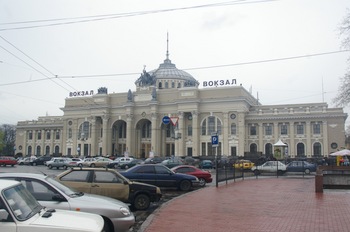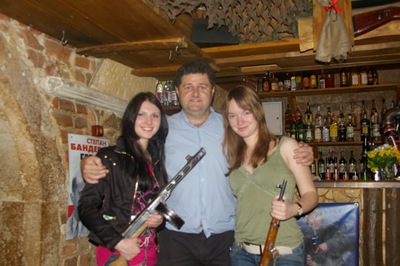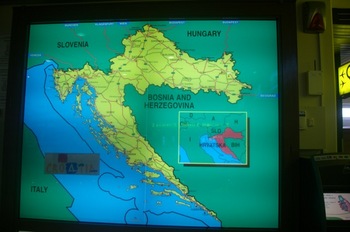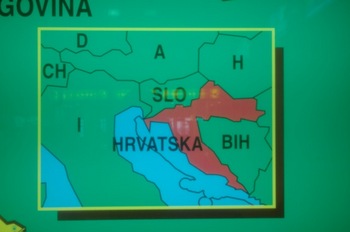We are developing the social individualist meta-context for the future. From the very serious to the extremely frivolous... lets see what is on the mind of the Samizdata people.
Samizdata, derived from Samizdat /n. - a system of clandestine publication of banned literature in the USSR [Russ.,= self-publishing house]
|
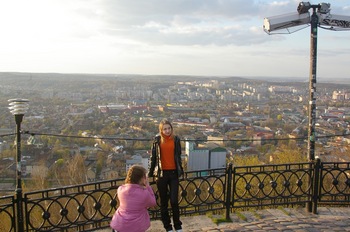
The Julie Delpy lookalike in the High Castle. Lviv, Ukraine. April 2010 On April 21 this year, I was in Odessa, on the Ukrainian Black Sea coast. I was booked on a scheduled Ryanair flight from Katowice in Poland the following evening at 8.25pm. No flights had flown out of Poland or into England for a week, but I had suddenly been informed that I had 27 hours in which to get at Katowice airport.
I have written a lengthy piece about this journey, giving history, sundry political and economic observations, and a description of just how I came to be in Odessa on April 21. Unfortunately, this blog post somehow managed to come to over six and a half thousand words, which is perhaps excessive.
Therefore, I have done some editing. The introduction to the post that gives all the background is on my own blog here. On Samizdata, I will post from the point where the action starts.
The first step was to get from the Black Sea coast to the Polish border. There was a train departing Odessa for Lviv at 7.00pm. I purchased a ticket. → Continue reading: Smoked fish thrust at me after midnight, and cigarette smuggling in the snow.
… the Greens won an MP in the enclave of Brighton, but their share of the vote fell. I find this quite amazing, really. After five years of relentless environmental yakkery in the mass media, bombarding us on all channels at once, the Greens received a lower share of votes than the BNP. All that most Greens can now look forward to is to return to their yurts, and prepare for recycling.
– Andrew Orlowski, writing in the Register, and reaching the fairly sensible conclusion that the reason every political party did badly was because they are all intellectually bankrupt, and the public is starting to get this. Read the whole thing.
It is impressive just how much I would like to see this lot annihilated and humiliated in the election, all considered.
As the crisis goes on, things are getting pretty grim
 Rzeszow, Poland, April 2010 Yes, I understand that this is actually a straightforward translation of a common word into Polish, but if I ever open a bar, “Alkohole” will be a great name for it.
As it is, I am now in the Ukraine, a little to the east of Rzeszow. Given the closure of most European airspace, I have no idea whatsoever how or when I am going to return to the UK. One option would be swearing.
 This is also presumably a straightforward translation into Polish? Another option, and the one I will be taking up, would be to just potter around for a bit. I am in no pressing hurry to return to London, and pottering around in this part of the world is not expensive. I could try and return by surface transport, but crowds and crushes and expenses and sold out trains and ferries do not sound like much fun. I may even head east for a bit. Odessa and Crimea sound interesting.
 Lviv, Ukraine. April 2010 I was given a fairly serious “These foreigners are crazy” look when I started photographing the salt and pepper shakers in the restaurant. Such are the joys of being a photographer. On the other hand…
 Lviv, Ukraine. April 2010
Nobody on this blog has yet commented on the terrible events near Smolensk in Russia yesterday morning, so I will take a brief moment to do so myself.
President Lech KaczyŠ„ski of Poland was probably best described as a conservative rather than a liberal, and was not someone who the people on this blog would agree with on everything. However, he was someone who lived under tyranny, and when faced with the question of whether you give in to such a tyranny or stand up to it, he stood up to it, and he spent a considerable time in prison as a consequence. Most of us are fortunate not to be tested in such a way, but here was a man who was tested and passed the test. For that he deserves immense respect. He was also about as pro-American and pro-Western as possible. For that also, he has my thanks.
I am shaken, I suspect with much of the population of Poland, by the horrible historical irony. 88 members of the Polish elite, including pretty much the entire top brass of the Polish armed forces, died near Katyn forest yesterday morning. This is terrible. My sympathy to the friends and family of all these good people.
One of the interesting exhibits in the pantheon of attempted explanations for the current financial crisis is the Kingdom of Spain. Spain had a massive real estate driven asset bubble, which has since collapsed. There is high unemployment, horrible public sector budget deficits, and lots of abandoned, half built housing projects around the coast. (In January, I struck up a conversation with some Australian engineers at the next table in a restaurant at lunchtime in the business district of Hanoi. Upon asking them how business was, they told me that there are lots of construction projects going on, but they were being undercut on price by Spanish and Italian companies. When domestic demand collapses, you look elsewhere).
And yet, Spain has not had a financial crisis. Spain’s banks are generally solvent and in good shape. One explanation of this is that financial crises in other economies are more a symptom of the economic crisis rather than its cause. Asset bubbles end badly. Government overspending has consequences.
One of Spain’s banks, Grupo Santander, has been expanding steadily throughout the world for a little over a decade. Unlike certain other banks of an expansionary nature (Royal Bank of Scotland, cough), Santander did not combine the acquisition of foreign banks with stupid lending, and so when the global banking sector fell in a heap a couple of years ago, Santander did what sound companies often do, and went looking for cheap assets. These included the small UK bank Alliance and Leicester, and the branch network and savings business of Bradford and Bingley (after its toxic assets had been nationalised by the UK government). Santander was an attractive buyer from the perspective of the UK government, as its expansionary frame of mind meant that it was unlikely to close branches and shed lots of employees.
My general inclination here is to compliment the management on running a good business. However, there is something disturbing, just the same. I have felt this for a while. Spanish financial institutions (and in truth Spanish organisations of all kinds) have a thing for building office complexes in the suburbs of Madrid that look like something out of a James Bond movie. It would be mean to say something about lingering residues of fascism here, so I will not do this.
However, the new headquarters (er, sorry, I mean the Ciudad Grupo Santander) shown in the above video really does appear to be a doosey. Professor Parkinson would no doubt have something to say here, but I feel oddly positive. However much I sometimes think that people who make corporate videos of this kind are best when placed on the B-Ark, being driven around by bright red Spanish banko-robots is certainly going to make marketing visits to foreign financial institutions a lot more fun. (Do they bring in Lewis Hamilton to race them on AGM day? Jokes about “augmented reality” in banking could go on and on, too).
It’s a shame that they have to build this sort of thing in Madrid, though. Building it (perhaps on an artificial island?) next to the private zoo in King Alfonso XIII’s weird coastal folly in the actual Ciudad (non-Grupo) Santander would be fitting, in some unexplainable way.
Link via Bruce Sterling.
An unfolding saga in the game of cricket in recent years has been the question of whether technology should be used to aid umpires in the case of close or potentially controversial decisions. Like many things in life, the question of whether to do this has turned out to be more complex than it may at first have appeared to be. There have been situations in which the on field umpire has asked for a replay, and the replay has been unclear but has none the less been used to overrule an on field umpire who probably saw more. There have been situations in which the players have appealed to a video replay that didn’t show anything, when they likely knew themselves what had happened and the situation would previously have been resolved with a gentlemanly code of conduct. There have been situations when the television company did not manage to produce the appropriate replay in time, and the umpire then made a decision that was revealed to be incorrect five minutes later. Many decisions depend on whether the batsman hit the ball, and a mixture of sound and picture is used to make these decisions, and determining which items of the bat, ball, ground, clothing, safety equipment etc came in contact with each other is often no clearer using the technology than not.
Fans of other sports are no doubt nodding at this point, as similar issues have come up in most sports that have attempted similar things. Cricket has one further issue, not unique to it but relatively central to it, which is the question of how technology should be used in the interpretation of the leg before wicket rule (LBW).
One of the principal ways of getting a batsman out is for the bowler to bowl at the batsman, for the batsman to miss the ball, and for the ball to then strike the wooden stumps behind him. It would be possible for a batsman to avoid getting out this way by his simply standing in front of the stumps at all times. In order to avoid this, the rules of cricket allow for a batsman to be out if he is standing directly in front of the stumps, the ball hits his leg, and the ball would have gone on to hit the stumps. (The rule is actually more complex than this, but the complexities are not relevant to the point I am making). The umpire stands in a good position from which to judge whether the ball will hit the stumps, and traditionally the umpire’s judgment has been used to decide whether the ball would have hit the stumps.
Umpires inevitably make mistakes, and there have been many accusations of umpire bias over the years. For a long time people have been watching replays in slow motion on television in order to second guess umpires, but these have never been conclusive. Occasionally an umpire will make an obviously wrong decision, but most of the time there is as much of an element of doubt watching at home as there is for the umpire. Or perhaps more: the umpire is in a better viewing position than the TV cameras.
In recent years, however, things have changed. The “Hawk-eye” system was initially used by television companies, and there was then pressure for it to be used in assisting umpires as well. Basically, this system looks at a number of video replays, and from them constructs a three dimensional model of the ball, the pitch, the bat, etc. From the this model, the path of the ball is extrapolated going forward. Television viewers see a computer graphic image of the ball hitting (or not) a computer graphic image of the stumps, and are told whether the ball would have hit the stumps and whether the batsman was or was not out.
Every since this system has been in place as part of television coverage, there has been pressure for it to be used in umpiring decisions. When people have asked me about this, I have stated my position with unexpected vehemence, particularly given that I am generally in favour of using video replays as part of the adjudication process. For I am, at present, unequivocally opposed to the use of Hawk-Eye and similar decisions in umpiring decisions.
My reason for this is as follows. → Continue reading: Of cricket and climate
Yesterday, upon arriving at Pula airport in Croatia, I found a helpful map on one of the walls, showing the highlights of the country, and with a useful inset showing where Croatia fits in with other nearby countries.
I suppose they could have sent explorers to discover what actually exists in that uncharted wilderness to the east of Zagreb and Bosnia, but I suspect it was not worth it.
The Australian state of Western Australia has a population of 2.2 million people, and occupies an area of just over 2.6 million square kilometres. Just for reference, that is seven and a half times the size of Germany or alternatively ten times the size of Texas.
However, average house prices are amongst the highest in the world, as there is a shortage of land.
It rather boggles the mind.
Correction: Texas is actually slightly more than a quarter of the size of Western Australia. My apologies to Texans.
Jack lost his iPhone last night. He has therefore been stuck at home on his Playstation 3 all day.
– An (early twenties, male) customer overheard in a coffee bar in the East End yesterday afternoon. I can understand how the world outside the front door is a scary, scary place if it is just you, completely unaugmented.
|
Who Are We? The Samizdata people are a bunch of sinister and heavily armed globalist illuminati who seek to infect the entire world with the values of personal liberty and several property. Amongst our many crimes is a sense of humour and the intermittent use of British spelling.
We are also a varied group made up of social individualists, classical liberals, whigs, libertarians, extropians, futurists, ‘Porcupines’, Karl Popper fetishists, recovering neo-conservatives, crazed Ayn Rand worshipers, over-caffeinated Virginia Postrel devotees, witty Frédéric Bastiat wannabes, cypherpunks, minarchists, kritarchists and wild-eyed anarcho-capitalists from Britain, North America, Australia and Europe.
|


